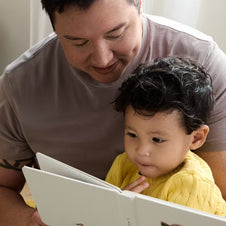Do you have a baby or toddler who only wants Mom or only wants Dad? I know this can feel so tricky and frustrating for everyone involved. Let’s talk about it.
Taking Cara Babies Classes
What are the reasons your baby or toddler only wants Mom or only wants Dad?
If you’re wondering why your baby only wants one parent, here are some possible reasons:
-
Your child is more familiar with one parent. Often when babies or toddlers spend most of their time with one parent, they begin to prefer that parent. This is simply because that parent is more familiar and not a sign that there’s anything wrong or missing in their relationship with the other parent.
-
Your baby or toddler is excited to see the parent they see less. Some little ones may instead prefer the parent that they spend less time with during the day. This parent is a novelty, which can make them more exciting.
-
Your baby is breastfed. Breastfeeding infants tend to prefer their mom.
Expert Tip: Having a “favorite” parent doesn’t mean that one parent is better (or worse) than the other parent. Parental preference is simply part of normal childhood development (and it often changes over time).
At what age do babies start to prefer Mom?
Almost immediately.
Research shows that in the early weeks and months, babies are often more drawn to maternal smells– like the smell of amniotic fluid, breastmilk, etc.. Additionally, because many mothers are the primary caregiver in the first few months, their faces and voices become more familiar to their babies.
What do you do when your baby or toddler prefers one parent?
If your child has a strong preference for one parent, I know this can feel both frustrating and exhausting for both the preferred and non-preferred parent. Instead of allowing it to become a conflict between parents, try to work as a team against the problem. Work together to spread out the work, love, and parenting when possible.
Here are some practical tips:
1. Try not to let this hurt your feelings — it’s not personal!
Your baby or toddler’s current preference is not an indicator of your parenting skills, your baby’s love, or your future relationship. These parental preferences are often fluid and change over time.
2. Validate your little one’s emotions, but hold firm.
We can acknowledge our baby or toddler’s big feelings, without “giving in” to their every desire. For example, if Daddy is the favorite today, say aloud: "I love Daddy too. He is so fun and makes me laugh also, but I'm the one who is getting you dressed today. Do you want the red shirt or green shirt?” OR If you tell your child “It’s Daddy’s turn to do bedtime tonight.” then it’s important to follow through with this. It’s okay if this upsets them. We are going to continue to validate their feelings, stay calm, and hold firm. This steady confidence from your parenting helps your child adapt when things are challenging for them.
3. Give the non-preferred parent solid 1-on-1 time.
The preferred parent's instinct is often to jump in and help. Instead, try to plan times when the preferred parent will be “unavailable.” (Maybe this looks like finally taking that long shower, running an errand, or taking a walk around the block.) This allows the non-preferred parent 1-on-1 time to take care of and bond with your little one. It also shows your child that both parents can meet their needs.
4. Acknowledge that each parent might do things differently.
I want you to really hear my heart on this one. I know that this can be so hard. If you are the preferred parent, you and your little one might be used to things being done a certain way. The other parent might do things differently. Sure, feel free to communicate what you've seen work, but try to let them find their own rhythm. What works best for one parent might not be the same as what works for the other parent. Allowing these small differences can reduce parental conflict, encourage flexibility, and allow each parent to have a unique bond with your child.
5. Include everyone in the routine!
Does one parent always do the bedtime routine? Find ways to include the other parent. Work together to ease the transition. Maybe this means you do the bath but the other parent helps with brushing teeth. Maybe your little one sits on your lap while the other parent reads a bedtime book. Gradually add in more and more time until either parent can fly solo in the bedtime routine.
Expert Tip: Does it feel like any changes will throw off your whole day or make bedtime hard? Or maybe sleep is always tricky? I can help. My classes will give both parents a clear plan for sleep. I want you to feel confident and prepared together. I’ll help you set your days and nights up for success no matter who the preferred parent is that day!










